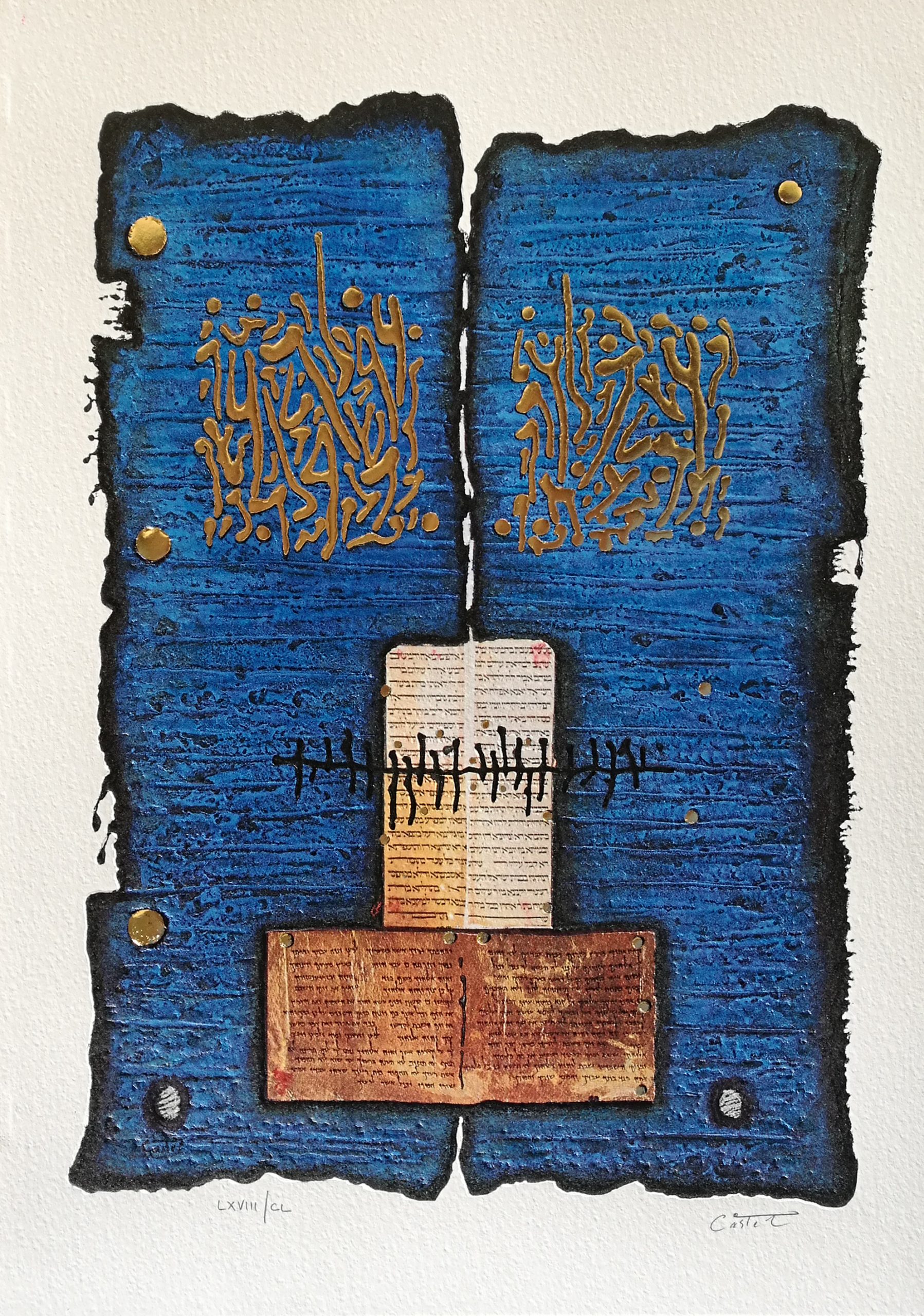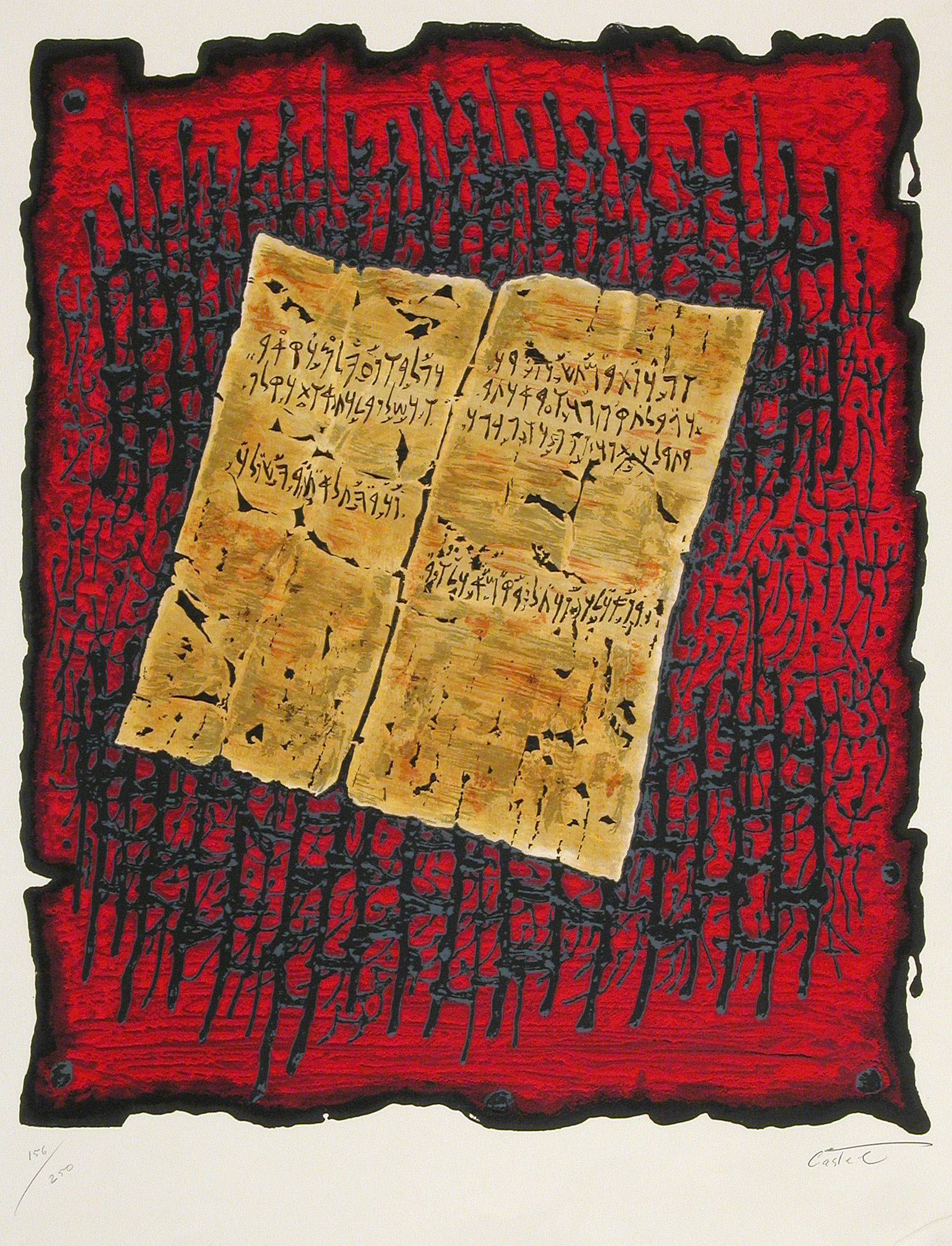Moshe Castel

Castel Moshe
Isaiah Prophecy
$300
13.5x19.25 34x49 Signed in the plate Lithograph
Shipping & Handling: $30
MOSHE CASTEL
Painting, for Moshe Castel, is a vital preoccupation, at all times. He is one of the artists whose life is synonymous with and consecrated to his art. And while he has experimented with other trends, he always returns to the inspirational fonts from which he drank during childhood, filling his paintings with oriental landscapes, capturing the romantic atmosphere of Eretz Israel, the hues of burning heat and the shadows of the vaulted houses; capturing, too, the mingling of cultures evident here.
Born to Sephardic Jews who trace their ancestry back to the expulsion from Spain and settled in Hebron, Castel revealed a penchant for art at the youthful age of six. In this he was inspired by the artistic talents of his father, a scholar and scribe whose superb calligraphy on Torah scrolls and ornamental embroidery on silk Torah coverings was renowned.
Castel entered the Bezalel School of Art at the age of 13, and spent three years studying arts and crafts. The young man’s talents were so pronounced that his teachers suggested he be sent to France for further studies, and Castel left for Paris in 1927, at the age of 18. Ten years of struggle, hardship and assiduous study of the various techniques of art followed. Castel returned to Israel as the Second World War broke out. Drawn to the city of Safed, the seat of Jewish mysticism, he decided to settle in this city of twisting lanes, magnificent scenery and ancient synagogues. Ensconced in his studio, Castel closed his door to visitors, and devoted himself to his art.
Castel brought from Paris a fresh, Parisian flair, and the influence of Utrillo and Vlaminck. But his renewed affinity to the land of his forefathers induced him to depict the lives of Sephardic Jews in Israel. The influence of Persian miniatures is evident in his paintings, and Castel refined them, adding great charm to themes of local color and patriarchal motives. This period lasted through the thirties and forties. Castel achieved great renown, and was extremely successful in his exhibitions. Castel was influenced for a time by the oriental colorfulness of Georges Rouault and by an awareness of Chagall. But the impact of mysticism gradually took another form, and Moshe Castel discovered his own technique of painting, in which color and texture; picture and relief became joined. This turning point, realized in 1948, evolved around the use of a technique which utilized ground basalt rock, mixed with sand and glue and infused with the rich colors that were characteristic of the artist. Castel’s painting, regardless of epoch, always possessed a singular vitality of color, in which every bloc of color carries its own specific meaning. With this new technique, the artist produced paintings portraying indecipherable ancient Hebrew script, whose panels evoke the feeling of a union of past and present. Desolation can be sensed in the seared scenes of land. The Hebrew letters are used not to verbalize, but to fuse the mounting syllables to link the viewer with the past. An archaic spirit emanates from them, the ancient spirit of the people.

Castel Moshe
The Prophecy
$400
22" x 30" Lithograph 1983 Edition 250
Shipping & Handling: $30
MOSHE CASTEL
Painting, for Moshe Castel, is a vital preoccupation, at all times. He is one of the artists whose life is synonymous with and consecrated to his art. And while he has experimented with other trends, he always returns to the inspirational fonts from which he drank during childhood, filling his paintings with oriental landscapes, capturing the romantic atmosphere of Eretz Israel, the hues of burning heat and the shadows of the vaulted houses; capturing, too, the mingling of cultures evident here.
Born to Sephardic Jews who trace their ancestry back to the expulsion from Spain and settled in Hebron, Castel revealed a penchant for art at the youthful age of six. In this he was inspired by the artistic talents of his father, a scholar and scribe whose superb calligraphy on Torah scrolls and ornamental embroidery on silk Torah coverings was renowned.
Castel entered the Bezalel School of Art at the age of 13, and spent three years studying arts and crafts. The young man’s talents were so pronounced that his teachers suggested he be sent to France for further studies, and Castel left for Paris in 1927, at the age of 18. Ten years of struggle, hardship and assiduous study of the various techniques of art followed. Castel returned to Israel as the Second World War broke out. Drawn to the city of Safed, the seat of Jewish mysticism, he decided to settle in this city of twisting lanes, magnificent scenery and ancient synagogues. Ensconced in his studio, Castel closed his door to visitors, and devoted himself to his art.
Castel brought from Paris a fresh, Parisian flair, and the influence of Utrillo and Vlaminck. But his renewed affinity to the land of his forefathers induced him to depict the lives of Sephardic Jews in Israel. The influence of Persian miniatures is evident in his paintings, and Castel refined them, adding great charm to themes of local color and patriarchal motives. This period lasted through the thirties and forties. Castel achieved great renown, and was extremely successful in his exhibitions. Castel was influenced for a time by the oriental colorfulness of Georges Rouault and by an awareness of Chagall. But the impact of mysticism gradually took another form, and Moshe Castel discovered his own technique of painting, in which color and texture; picture and relief became joined. This turning point, realized in 1948, evolved around the use of a technique which utilized ground basalt rock, mixed with sand and glue and infused with the rich colors that were characteristic of the artist. Castel’s painting, regardless of epoch, always possessed a singular vitality of color, in which every bloc of color carries its own specific meaning. With this new technique, the artist produced paintings portraying indecipherable ancient Hebrew script, whose panels evoke the feeling of a union of past and present. Desolation can be sensed in the seared scenes of land. The Hebrew letters are used not to verbalize, but to fuse the mounting syllables to link the viewer with the past. An archaic spirit emanates from them, the ancient spirit of the people.